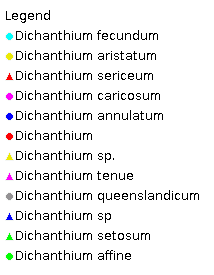Dichanthium Ann. Bot. (Usteri) 18:11 (1796).
Derivation:. From the Greek dicha (in two) and anthos (flowers, alluding to the two kinds of spikelet pairs in the raceme).
Taxonomic revisions, nomenclatural references:. J.M.J.de Wet and J.R.Harlan, Bol. Soc. Arg. Bot. Arg.12: 206–277 (1968); B.K.Simon, Austrobaileya 1: 457–459 (1982) and B.K.Simon, Austrobaileya 3: 82–84 (1989).
Key references (keys and floras):. G.Bentham, Flora Australiensis 7: 529–532 (1878) as Andropogon in part; C.A.Gardner, Flora of Western Australia 1 Gramineae 324–333 (1952); J.W.Vickery, Flora of New South Wales, Gramineae 19: 45–49 (1961); E.E.Henty, Manual Grasses New Guinea 67, 69, 72 (1969); M.Lazarides, Tropical Grasses S.E. Asia 32–33 (1980); M.Lazarides, Flora of Central Australia 487–488 (1981); J.C.Tothill and J.B.Hacker, Grasses of Southern Queensland 186–189 (1983); J.P.Jessop, Flora of South Australia 4: 1988 (1986); B.K.Simon, Flora of the Kimberley Region 1145, 1147 (1992); B.K.Simon, Key to Australian Grasses 98–99 (1993); S.W.L.Jacobs and S.M.Hastings, Flora of New South Wales 4: 441–443 (1993); N.G.Walsh, Flora of Victoria 2: 620–621 (1994); D.I.Morris, Student's Flora of Tasmania 4B: 354–355 (1994); D.Sharp and B.K.Simon, AusGrass (2002); J.P.Jessop, Grasses of South Australia 516–518 (2006); S.W.L.Jacobs, R.D.B.Whalley & D.J.B.Wheeler, Grasses of New South Wales, 4th Ed, 206–208 (2008).
W.D.Clayton & S.A.Renvoize, Genera Graminum (1986), genus (591).
Native and naturalised. About 16 species, from Old World Tropics. 8 species in Australia, WA, NT, SA, Qld, NSW, Vic, and Tas. Also New Guinea and Malesia.
Habit. Annual (rarely) or perennial, rhizomatous or stoloniferous or tufted or decumbent. Leaf blades narrow. Ligule an unfringed membrane to a fringed membrane.
Inflorescence. Inflorescence of spicate main branches (many-jointed racemes) or paniculate (the lower racemes being sometimes branched again at the base), a single raceme or spike or of digitate or subdigitate racemes or spikes, digitate or subdigitate (the racemes often almost palmate, towards the culm tips), spatheate or espatheate, a compound pseudo-inflorescence or not a compound pseudo-inflorescence. Spikelet-bearing axes racemes, joints usually with more than 10 spikelet-bearing joints, with heteromorphic spikelets (the pedicellate spikelets smaller, awnless) or with homomorphic spikelets, solitary or paired or clustered, with spikelets in pairs, one sessile, the other pedicelled, disarticulating at joints. Pedicels and rachis internodes without a longitudinal, translucent furrow. Internodes disarticulating transversely, densely long-hairy or somewhat hairy or glabrous.
Spikelets. Spikelets dorsally compressed, 2 flowered, with 1 fertile floret, paired (with a terminal triplet), sessile and pedicelled, in pedicelled/sessile combinations; sessile spikelet with lower incomplete floret. Fertile spikelets falling with glumes.
Glumes. Glumes relatively large, more or less equal, long relative to adjacent lemmas, awnless, dissimilar (the lower bicarinate, the upper narrower and naviculate). Lower glume two-keeled, convex on back to flattened on back, relatively smooth, 5–9 nerved. Upper glume 1–4 nerved.
Florets. Lower incomplete floret(s) sterile. Lemmas awnless, 0 nerved, similar in texture to fertile lemmas, not becoming indurated. Fertile florets 1. Lemmas reduced to a linear, hyaline stipe, produced into the awn, less firm than glumes, not becoming indurated, entire at apex, awned, 1–3 nerved, glabrous. Awns 1, apical, geniculate, hairless (glabrous), much longer than body of lemma. Palea present or absent, when present, very reduced, nerveless. Callus blunt. Lodicules 2. Stamens 1–3. Grain small, compressed dorsiventrally. Hilum short. Embryo large. Pedicels free of rachis. Pedicelled spikelets present, similar in shape to sessile spikelet, sterile or male.
Kranz Anatomy. C4.
2n = 20, 40, 50, and 60, 2, 4, 5, and 6 ploid, commonly adventive.
Habitat. Helophytic to xerophytic. Habitats from marshes to subdesert and disturbed ground. Species of open habitats.
Classification. Panicoideae; Andropogoneae.
Notes. Dichanthium may be recognized by its homogamous pairs and obtuse sessile spikelets, but some species lack these features and approach closely to Bothriochloa, from which they are rather arbitrarily separated by the solid pedicels (Clayton and Renvoize, 1986).
Types Species. D. nodosum Willemet = D. annulatum (Forssk.) Stapf.
Biogeographic Element. Clifford & Simon 1981, Simon & Jacobs 1990: Old World Tropics.


